Header logo
header top contact widget
periodontal plastic surgery
3 At-Home Tips To Lower Risk of Tooth Loss, Gum Disease
Posted on Jun 02, 2023 by William J. Claiborne, DDS MS
Gum disease is the nation’s leading cause of adult tooth loss and one of the most prominent diseases in the U.S., with over 47% of adults having some level.
Yet, this disease is far more devastating than many realize. When oral bacteria build to a point beyond the ability of the immune system to manage, inflammation sets in. This inflammation continues to build as the oral bacteria become infectious.
Oral bacteria is the cause of cavities, gum disease, and a long list of health problems as many years of research has shown. Oral bacteria can become bloodborne through tears in diseased gum tissues, allowing it to travel throughout the body. This can trigger inflammatory reactions that have serious consequences far beyond the mouth.
Because the initial symptoms of periodontal (gum) disease are silent, the early stages of the disease can be perplexing since patients don’t feel anything is wrong. However, like most diseases that form in our bodies, we don’t feel or see anything when they first begin. This allows the disease to progress without our knowledge.
Unfortunately, people tend to delay treatment until the symptoms of periodontal disease are obvious and uncomfortable. These include tender and swollen gums that bleed easily when brushing, consistent bad breath, and gums that are red in color rather than a healthy pink. As gum disease progresses, pus pockets form around teeth as bacterial accumulate. Eventually, teeth will loosen and need to be removed.
Although gum disease can begin without any obvious symptoms, once it exists, progression occurs in three stages (without treatment).
• Gingivitis – As the initial stage of gum disease, inflammation is triggered by plaque buildup at the gum line. When daily brushing and flossing fail to thoroughly remove plaque, toxins form that cause irritation to the gum tissues. Once signs emerge, they may include seeing blood in the sink when brushing or having sore, swollen gums. At this stage, however, damage may be reversed with prompt response.
• Periodontitis (gum disease) – As the disease progresses, the bone structures and fibers that support teeth are damaged by the destruction of infectious oral bacteria. At this stage, inflamed gums form pockets below the gum line, filling with bacteria-laden plaque.
• Advanced Periodontitis – In the advanced stage of gum disease, fibers and bone supporting natural teeth are destroyed. This can cause teeth to shift or loosen, requiring aggressive treatment to prevent tooth loss. Eventually, some teeth may require removal.
As devastating as tooth loss can be to one’s overall health, the bacteria of gum disease can enter the bloodstream. Research has shown this infectious bacteria can trigger inflammatory reactions elsewhere in the body, correlating to heart disease, stroke, high blood pressure, some cancers, diabetes, arthritis, impotency, preterm babies and more.
Obviously, it is important that people are diligent in the care of their oral health. Yet, statistics in America along these lines are not impressive. The Center for Disease Control’s Division of Oral Health cites that 1 out of every 2 American adults 30 and over has periodontal disease. They also shared that periodontal disease is higher in men than women (56.4% vs. 38.4%) with high prevalence rates among smokers (64.2%) and adults 65+ (70.1%).
As a proponent of dental implants to replace lost teeth, I must acknowledge that there is no perfect replacement for natural teeth. Natural teeth provide a stable, dependable means to chew and enjoy food while their tooth roots keep the jaw bones that support them nurtured and stimulated.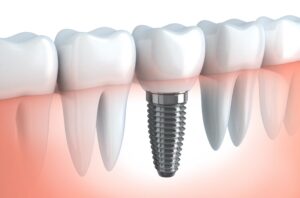
In addition to restoring chewing strength and stability, the dental field is a proponent of dental implants largely because of their ability to halt bone loss. Referred to as ‘resorption,’ this is the shrinking of bone mass, which occurs when tooth roots are no longer present in the jaw bone.
Once resorption begins, it continues at an ever-increasing rate with each year. For those who wear a denture or partial, the pressure an appliance places on the bone ridge accelerates it further. Sleeping in an appliance puts pressure on the ridge 24/7, speeding up the rate of bone loss even more.
Resorption can even be seen; it ages one’s appearance far beyond their actual years. As the jaw bone thins, deep wrinkles form around the mouth. Over time, the mouth appears to have sunk into the face. Jowls form and the chin becomes more pointed (creating a ‘granny look’).
Throughout all this, a denture or partial easily slips, requiring more frequent applications of adhesives or pastes. Relines may help for a time, but each reline will only help for a temporary time as the bone continues to decline in height.
Because dental implants are positioned in the jaw bone, they recreate stimulation, which helps them maintain healthy bone mass. They provide dependable, comfortable chewing and speaking ability. And, best of all, they’re designed to last a lifetime.
However, the goal is to avoid the devastation of gum disease. And, this begins at home. While your involvement with your general dentist is very important (with check-ups and cleanings every six months), daily care is a necessary part of having a healthy mouth, lowering disease risks, and keeping your natural teeth (or halting the pace of further tooth loss).
How can you improve your at-home care? There are several ways you can up your game with a few simple add-on’s…
Findings of an 11 year study published in the Journal of Clinical Periodontology tracked the oral health of over 2800 adults. Their use of ELECTRIC TOOTHBRUSHES was monitored to watch for periodontal disease, cavities, and the number of natural teeth.
Participants were examined in 2002 – 2006, with 18% being electric toothbrush users. Follow ups were conducted after 6 and 11 years. At the time of their 11 year follow up, 37 had converted to using electric toothbrushes.
The study showed electric brushing promoted better gum health and slower progression of gum disease. Electric tooth brushing also related to a reduction in tooth loss by 20% (compared to those who brush with manual toothbrushes).
Although manual tooth brushing can be just as effective, it must be done in a proper manner. For manual brushers, some manual brushes can actually be destructive used incorrectly.
For instance, a hard bristle tooth brush can wear down tooth enamel and gum tissues. Too, some people feel the need to press down firmly when brushing and tend to use a scrubbing, ‘back & forth’ motion. This action can wear down the protective shell of tooth enamel, leaving teeth more vulnerable to decay.
To avoid damaging tender gum tissues, choose a soft bristle toothbrush. As you apply gentle pressure on the brush, use a swirling motion. By using a circular pattern over both sides of each tooth and along the tops, teeth are cleansed without wearing away gum tissues. Hint: If the bristles on your toothbrush are fanned out after a couple of months, it’s because you are applying too much pressure when brushing.
Whether using a manual or electric tooth brush, it is necessary to brush twice a day for effective results. In order to thoroughly remove the sticky film of plaque from teeth, you should also brush at least two minutes each time.
Another way to improve gum health, lower cavity risk, and prevent tooth loss is through FLOSSING. It is estimated that only 31% of American adults floss on a daily basis. Because brushing cannot dislodge all food particles caught between teeth, daily flossing should be a part of oral hygiene routines.
Proper flossing is easy for those who are in the habit of it and takes less than a minute. However, the key word here is “proper.” Flossing is best done with about 18 inches of floss. We recommend unwaxed but people with tight teeth find waxed helps them avoid having to ‘pop’ in-between teeth, which can cut into tender gum tissues. Wrap both ends of the floss around the forefingers. Use the thumbs and middle fingers to help maneuver the floss.
Go slowly as you move the floss back and forth to get in-between and scrape down each tooth’s side several times. Move the floss just slightly below the line where teeth meet gum tissues to dislodge bacteria at the base of teeth. Adjust the floss so you have a clean section after flossing every 3-4 teeth. Be sure to scrape the backs of molars (or the farthest back teeth) on top and bottom.
For those who have problems with manual dexterity or find the maneuver awkward, WATER FLOSSERS are effective alternatives (shown to be just as effective as manual flossing) and easy to use. A water flosser pulsates a stream of water between teeth that is forceful enough to dislodge trapped food bits but without harming teeth or gums. They are affordable, available online or in many stores, and easy to use.
Finally, I’ll add the need to keep the mouth moist. A frequent state of ORAL DRYNESS can cause bad breath and lead to higher risks of cavities and gum disease. Saliva, the mouth’s natural rinsing agent, helps to cleanse oral bacteria from the mouth. This keeps bacteria to a minimum and their ability to cause problems at lower risk.
When saliva flow is insufficient, however, bacteria are able to accumulate and multiply rapidly. Contributors to having a dry mouth can occur from consuming alcoholic beverages, caffeine, many medications (both OTC and Rx) and is a normal part of the aging process. Some medical conditions, including acid reflux, sinus infections, diabetes and bronchitis can also cause dry mouth. A bad cold, snoring or just being in the habit of breathing through the mouth are drying as well. Smoking is a major cause of dry mouth.
To overcome the risks imposed by a dry mouth, drink lots of water throughout the day (sports drinks and colas don’t count). Use an ORAL RINSE that is formulated to replenish moisture in the mouth. There are several available over-the-counter (look for ones that DO NOT contain alcohol, which is very drying to oral tissues).
As an Asheville periodontist, I specialize in the treatment of all stages of gum disease, the re-contouring of gum tissues, and the diagnosis and placement of dental implants. Our periodontal dental office optimizes patient outcomes and comfort through our vast array of advanced technology and a commitment to exceptional care. Call (828) 274-9440 to schedule an examination or ask to begin with a consultation.
If dental fear has prevented you from achieving the healthy, confident smile you desire, ask about Oral and I.V. sedation (“twilight sleep”). These are safely administered and recovery is generally quick.
Helping To Curtail Opioid Misuse
Posted on Mar 23, 2023 by William J. Claiborne, DDS MS
No one wants to be in pain. In the dental office, dentists and dental specialists see many patients enduring a great deal of pain, some of which increases in time to excruciating levels.
To resolve the pain, treating the affected area is the first step. Healing can take time and may involve a period of continued discomfort. While a dental profession wants to help patients avoid problems and pain that can arise from them, helping you get through painful periods with ease is certainly a priority.
Like others in the health care field, the field of dentistry has become rather resistant to prescribing harsh and addictive painkillers. The opioid epidemic in the U.S. is running rampant and we want to do our part in curtailing the availability of these meds.
I felt it may be helpful to share some statistics and research findings on the opioid use in America. Hopefully, this information will reassure that the dental profession is not being “stingy” with prescribing painkillers. We are trying to help control what can easily be misused or over-prescribed.
Drug overdose deaths involving prescription opioids rose from 3,442 in 1999 to 17,029 in 2017. From 2017 to 2019, the number of deaths declined to 14,139. This was followed by a slight increase in 2020, with 16,416 reported deaths. In 2021, the number of reported deaths involving prescription opioids totaled 16,706. These numbers are headed in the wrong direction, obviously.
Although physicians, dentists and others in health care have been under close scrutiny for the number of opioids prescribed, dentists are also being more diligent in limiting patient access to pain medications. Yet, there is still a concerning number who make access easier than it should be.
According to International Association for Dental Research findings shared from two studies amongst dentists and oral-maxillofacial surgeons (OMFS) (presented in March 2023), the goal is to identify high prescribers of opioids. The study, conducted at the University of Pittsburgh, used data to detect actively prescribing dentists between 2015-2019.
The study found that during this period, 2,741,030 opioids were prescribed by 199,145 dentists/OMFS. Researchers noted that over 35% of prescribers prescribed at low rates in 2015 with this percentage falling to nearly 18% in 2019. In this period, those who were “moderate” prescribers of opioids also decreased prescribing by over 82%. A slightly more active group of prescribers also decreased their number of these prescriptions.
However, 3.5% of prescribers found to be consistent in opioid prescriptions decreased in number, yet with minimal decline. For these, the rate in 2015 averaged nearly 55%. In 2019, the average was only down to 44.7%.
A particular concern in prescribing opioids is that of prescriptions submitted for children. While total opioid prescriptions have decreased in patients under 25 years of age, trends in opioid prescribing for children, adolescents, and younger adults (under 25 years of age) remains a concern.
In a study from 2013 – 2018, researchers found the opioid dispensing rate for younger patients decreased annually at a rate of approximately 15%. The largest decreases were noted for patients ages 15 to 24 years. Among children aged 0 to 5 years for whom an opioid was dispensed, the investigators observed annual increases from 2011 to 2014. For high-dosage prescriptions, these decreased from 2014 to 2018 although high-dosage, extended-release or long-acting remained at a concerning rate — nearly 28%.
Even amid an epidemic of abuse, opioid painkillers are still commonly prescribed to teenagers and young adults for conditions like tooth and back pain. Between 2005 and 2015, opioids were prescribed to teens and college-age adults at nearly 57 million visits to doctors’ offices and emergency departments.
Although more common in an ER, 15% of visits concluded with an opioid prescription with only a small decline over the 10-year study period.
A report on opioid prescription misuse by the University of Michigan shared another concern that contributes to the problem. When people get a prescription for opioid painkillers to ease pain, it is assumed that the patient has it filled right away. However, there are now findings that show some of these prescriptions are being filled more than a month later, long after acute pain should have subsided.
In 2019, 1% of opioid prescriptions from dentists and surgeons were filled more than 30 days after writing. Although the number is low, that percentage equates to more than 260,000 opioid prescriptions a year in the U.S.
This indicates to prescribing surgeons and dentists that the medications are being used for other than intended. Whether over-prescribed by the doctor or misuse by the patient, this adds to the risk factor for opioid overdose.
These delayed-fill findings have led to call for state and federal laws to better regulate the expiration periods for filling these prescriptions. Changing the systems of monitoring along these lines has been slow in coming. In 2019, 18 states allowed prescriptions for opioids and other controlled substances to be filled up to 6 months after writing with 8 states allowing dispension up to 1 year after the prescription date.
The entire team at our Asheville periodontal dental office is highly committed to providing patients with optimal comfort throughout treatment. Here, we make oral sedation available as well as I.V. sedation (“twilight sleep”). These help patients to relax fully or snooze during treatment, erasing most (or all) memory of treatment afterward.
We also want our patients to heal comfortably after periodontal treatment or dental implant placement. As a periodontist, this is helped by being respectful of gum tissues and all areas in the mouth DURING procedures. We work with each patient to help them remain comfortable during their post-procedure time. Often, this can occur without the need for heavy medications with many patients only requiring OCT pain meds.
When it comes to your treatment, our advanced imaging technology helps us to pinpoint precise areas for incisions, which helps to minimize discomfort and speed healing time. Additionally, performing treatment at an easy pace allows for minimal disruption to sensitive gum tissues.
A periodontist has advanced skills in the treatment of all stages of gum disease, the re-contouring of gum tissues, and in the placement of dental implants. This dental specialist can help provide an optimal result while helping you enjoy the highest level of comfort – during and after treatment.
Please call 828-274-9440 if you have questions about comfort, treatment, or dental fear. New patients are always welcome and a referral is not always needed.
When Dentures Are “Slippery,” “Wobbly, or “Rocky”…
Posted on Mar 11, 2023 by William J. Claiborne, DDS MS
A periodontal specialist has advanced training in the selection and placement of all dental implant types. Also a specialist in the treatment of all stages of periodontal (gum) disease and the contouring of gum tissues (such as to correct a “gummy smile”), many patients who come to us have lost teeth due to gum disease.
Gum disease is the nation’s leading cause of adult tooth loss. Sadly, over 47% of Americans over the age of 30 have some level of gum disease. Many do not realize they have developed gum disease since it can begin without obvious symptoms.
Periodontitis is the advanced stage of gum disease. Its symptoms are hard to ignore. Breath odor is putrid. The gums bleed easily, at times even when eating. The gums are a dark red and may have a spongy texture. Some teeth may loosen or shift. Pus pockets form around the base of some teeth.
In this advanced stage, some (or all) natural teeth may require removal. For those who choose to replace teeth with a denture or partial (versus dental implants), something occurs below the gums that cannot be seen. However, over time, the repercussions can be quite severe.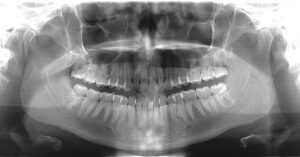
What I’m referring to is “resorption.” This is the term used for a shrinking jaw bone.
Resorption occurs when natural tooth roots are no longer present in the jaw bone. These tooth roots actually help to provide stimulation to the bone. Tooth roots also nourish the bone mass through connective tissues that extend down through a tooth’s interior.
When a tooth is removed, the stimulation and nourishment to that area of the jaw bone is taken away. Without it, the bone begins to shrink. As it declines in height, the adjacent teeth are more vulnerable to loss. Statistics show that teeth neighboring areas where natural teeth are missing will be the most likely to be lost next.
Although a denture or partial can mimic the presence of teeth above the gum line, there is nothing to keep the jaw bones healthy beneath, which is the sturdy foundation for biting and chewing strength. As tooth loss continues, one can go from losing a few teeth to losing all teeth (being “edentulous”).
Many people are unaware that the pressure of wearing dentures or partials accelerates the pace of resorption. For people who sleep in their dental prosthetic, the 24/7 pressure applied to the jaw bones speeds up the rate of bone decline even more.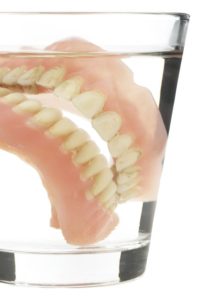
Sleeping in a denture can also add to higher risks for the flu and pneumonia. A 3-year study of more than 500 adults was published by the Journal of International Oral Health. Of the 186 (of 453 denture wearers) who did not remove their dentures for sleeping, they had over twice the risk for pneumonia than those who did. Sleeping in dentures also led to higher levels of tongue and denture plaque, gum inflammation and other oral issues.
For those who wear a denture or partial, losing jaw bone mass also causes a change in the way the denture or partial fits. For example, a denture may fit fine the first year after teeth are removed and a denture is custom-fitted. However, people eventually notice slips when biting or chewing. This is because the bone under the “arch” that supports the denture or partial is declining in height.
The changing foundation for the denture (also known as a ridge) allows it to “slip” or become “wobbly.” As bone loss continues, it causes uncomfortable rubbing on tender gums while eating.
As a result, people often adjust their diet to avoid foods that require rigorous chewing, opting for softer foods that require less chewing. Outings with friends and family become overshadowed by the fear of embarrassing slips.
Eventually, even frequent applications of denture pastes or adhesives are of little help. A reline may be recommended by your dentist to reshape the contours of the denture or partial to the slowly declining arch. Unfortunately, this process will continue as bone loss requires periodic relines as the arch flattens further.
The solution?
For most individuals who are missing one or more natural teeth, we advise replacing teeth with dental implants. A dental implant recreates the presence of a natural tooth. It provides stimulation to the bone, halting the process of bone loss.
Dental implants do not rely on neighboring teeth for support, as in a crown-&-bridge combination. The crowning of bordering natural teeth to support a bridge is not needed. Thus, the integrity of surrounding teeth is protected.
Because dental implants are supported by the jaw bone, sturdy and dependable biting and chewing strength is restored. Eating a healthy diet of the foods you love is again possible.
And, dental implants also have an exceptional success rate, higher than any implant-in-bone option. They are designed to last a lifetime, making them an excellent investment.
If you are considering dental implants to replace missing teeth, we invite you to begin with a consultation appointment. This will take place in a private room where we can discuss your needs and concerns. Call 828-274-9440 to schedule, or tap here for more contact information.
The “Why” & “How” of Dental Implants
Posted on Nov 09, 2022 by William J. Claiborne, DDS MS
According to the Centers for Disease Control & Prevention (CDC), over one-fourth (26%) of American adults ages 65 and older have 8 or less natural teeth. The CDC equates this number (having 8 or fewer teeth) as “severe tooth loss” since it impacts an individual’s ability to thoroughly eat a healthy diet.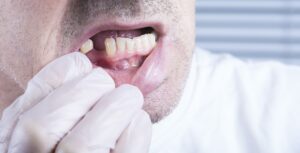
An even worse statistic shared by the CDC is 1 in 6 (17%) adults ages 65 and older have lost all of their teeth.
When it comes to losing natural teeth, they also share that the most vulnerable older adults are those who are poor, have less than a high school education, or are cigarette smokers.
Being totally edentulous (having lost all teeth) amongst the 65 or older age group has fortunately declined over the years. The CDC shared that the figure dropped by more than 30% from 1999–2004 (when it was 27%) to 17% in 2011–2016. At least American adults are moving in the right direction.
https://www.cdc.gov/oralhealth/fast-facts/tooth-loss/index.html
Tooth loss is a bigger deal than is assumed by a large segment of the population. When a natural tooth is removed, its absence causes a reaction that begins below the gum line. What occurs initially is typically not obvious. Yet, the repercussions of “resorption” can become quite the dilemma.
The absence of a tooth root in the upper or lower jaw bone is a loss of stimulation to the bone mass where it was once positioned. These roots provide both stimulation and nourishment that enables the bone to maintain a healthy mass. Without the presence of tooth roots, the bone begins to “melt away.” This process is known as resorption.
Think of the stimulation that tooth roots provide to how you might muscle atrophy. We all know that muscles, not used, will shrink in mass. When the jaw bones are lacking stimulation by the tooth roots they’re designed to hold, bone mass begins to shrink.
Resorption begins shortly after the tooth root is removed. Once it starts, it continues at an ever-increasing pace. For example, the first year after a tooth root is missing, the loss of bone may be minimal. With each passing year, the pace of loss accelerates.
As the bone shrinks in height, the natural tooth roots adjacent to the area of missing teeth are subject to movement and root damage. On average, the next teeth you’re most likely to lose are the ones bordering areas of missing teeth.
Obviously, it is important to replace lost teeth before bone loss begins. For the support of remaining natural teeth, it’s also important to replace missing teeth as soon as possible so adjacent teeth can retain their proper positions. And, it’s HOW you replace them that’s most important.
Because dental implants replace the tooth above the gum line AND the root portion below it, the bone is able to retain its mass. Through the sturdy foundation of the jaw bone, dental implants are able to restore the look, feel and chewing stability like that of natural teeth.
As a periodontist, I specialize in the prevention, diagnosis, and treatment of all stages of periodontal (gum) disease. I also have advanced training and skills in the selection and placement of dental implants. In addition, periodontists are particularly skilled in performing cosmetic periodontal procedures.
Our Western NC periodontal dental office features some of the most advanced technology available. This cutting edge technology is beneficial in a number of ways, with much specifically helpful in optimal dental implant diagnosis and planning. This includes:
LANAP With PerioLase MVP 7 – Laser-Assisted New Attachment Procedure is an advanced protocol that efficiently and effectively treats advanced gum disease with the added advantages of a dental laser. For patients who are preparing for dental implant placement, resolving gum disease prior to treatment is mandatory. LANAP offers a non-surgical alternative for patients with moderate to severe periodontal disease with very little discomfort and a quick recovery time.
Cone Beam Imaging – These amazing 3D “x-rays’ are ideal for diagnosing and treatment planning. The highly-detailed images provide a clear view of the upper and lower jaw. Because cone beam radiographs show sagittal, axial, and coronal planes, locating and tracking nerve canals optimizes implant placement. The images are captured in a quick, painless process and at minimal levels of radiation.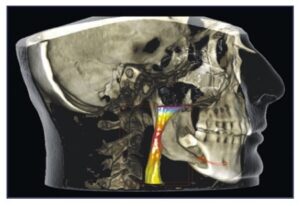
CareStream Cone Beam Computer Tomography Imaging – This enhanced tomography works with 3D imaging for exceptional detail and range.
Computerized Dental Implant Placement – This system provides the futuristic ability to position dental implants before the process actually begins. Through computerized technology, the implants are selected and “ideally positioned” on a 3D model of the patient’s jaw. From this, a template is developed for optimal treatment success, even for complex cases.
CS 3600 Intraoral Scanner – Rather than make impressions with bulky, goopy trays, this scanner quickly and comfortably captures digital impressions accurately and easily. These are used to create precision models or appliances (dental implant crowns, bridges, or full arches). The scanner can also reach hard–to–access areas in the patient’s mouth for superior results with improved patient comfort.
Sedation – Our Asheville periodontal practice is known for its environment of comfort and respectful care. We understand that over 70 percent of the adult population have some level of dental fear or anxiety. For optimal comfort and relaxation, we offer several sedation options, including oral and IV sedation. With both sedation options, patients are closely monitored with advanced safety equipment throughout treatment.
• Oral sedation is a pill that helps patients relax. It also has an amnesiac effect, leaving most with little or no memory of treatment afterward.
• I.V. sedation (also known as ‘twilight sleep‘) places the patient in a deeper sleep state and erases memory of the procedure. It is administered by a Medical Doctor (MD) who is a board certified Anesthesiologist.
Ideal diagnosis is important, and can save the patient much in overall treatment costs. For example, when missing more than one tooth in one area, one implant can often hold two or a bridge of teeth. Several strategically-placed implants may also be used support a full arch of teeth.
Dental implants restore the ability to eat with stability, chew comfortably, laugh and speak with confidence. Dental implants do not decay and will never need root canals. They have an extremely high success rate, higher than any implant-in-bone option. And, Dental Implants are designed to last a lifetime. With proper selection and maintenance, they will never need replacing or repair.
Dental implants come in many sizes and shapes, each system designed to accommodate various needs and preferences. This means your implant can be chosen to suit your long-term goals.
Proper placement and support in caring for implants is an important part of a successful outcome. However, dental implants can fail. This is why a periodontal specialist can be an asset to your investment. When dental implants are chosen and placed by a Periodontist, he or she can select the one that will work best for you now and throughout your lifetime.
In our Asheville periodontal dental office, we combine technology with our advanced skills and compassionate approach to care so you can enjoy a comfortable, efficient experience that allows you to have optimal success.
Call 828-274-9440 to arrange a consultation. During this time, we can discuss treatment that can achieve your needs and goals as well as the process and anticipated costs.
Recent Posts
Categories
Archives
- September 2024
- August 2024
- July 2024
- June 2024
- May 2024
- April 2024
- March 2024
- February 2024
- January 2024
- December 2023
- November 2023
- October 2023
- September 2023
- August 2023
- July 2023
- June 2023
- May 2023
- April 2023
- March 2023
- February 2023
- January 2023
- December 2022
- November 2022
- October 2022
- September 2022
- August 2022
- July 2022
- June 2022
- May 2022
- April 2022
- March 2022
- February 2022
- January 2022
- December 2021
- November 2021
- October 2021
- September 2021
- August 2021
- July 2021
- June 2021
- May 2021
- April 2021
- March 2021
- February 2021
- January 2021
- December 2020
- November 2020
- October 2020
- September 2020
- August 2020
- July 2020
- June 2020
- May 2020
- April 2020
- March 2020
- February 2020
- January 2020
- December 2019
- November 2019
- October 2019
- September 2019
- August 2019
- July 2019
- June 2019
- May 2019
- April 2019
- March 2019
- February 2019
- January 2019
- December 2018
- November 2018
- October 2018
- September 2018
- August 2018
- July 2018
- June 2018
- May 2018
- April 2018
- March 2018
- February 2018
- January 2018
- December 2017
- November 2017
- October 2017
- September 2017
- August 2017
- July 2017
- June 2017
- May 2017
- April 2017
- March 2017
- February 2017
- January 2017
- December 2016
- November 2016
- October 2016
- September 2016
- August 2016
- July 2016
- June 2016
- May 2016
- April 2016
- March 2016
- February 2016
- January 2016
- December 2015
- November 2015
- October 2015
- September 2015
- August 2015
- July 2015
- June 2015
- May 2015
- April 2015
- March 2015
- February 2015
- January 2015
- December 2014
- November 2014
- October 2014
- September 2014
- August 2014
- July 2014
- June 2014
- May 2014
- April 2014
- March 2014
- February 2014
- January 2014
- December 2013
- November 2013
- October 2013
- September 2013
- August 2013
- July 2013
- June 2013
- May 2013
- April 2013
- March 2013
- February 2013
- January 2013
- December 2012
- November 2012
- October 2012
- September 2012
- August 2012
- July 2012
- June 2012


